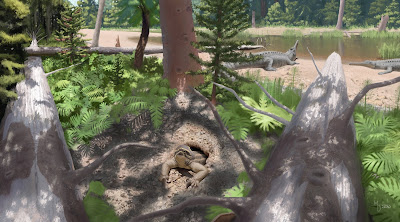 |
Skybalonyx skapter
Jenkins, Pritchard, Marsh, Kligman, Sidor & Reed, 2020
|
ABSTRACT
Fossils of drepanosauromorphs, a clade of non-saurian diapsids, were once considered relatively rare in the Chinle Formation of the southwestern United States as well as in Upper Triassic rocks globally. Recent discoveries have shown that there are at least four drepanosauromorph taxa present in the Chinle Formation including Dolabrosaurus aquatilis, Drepanosaurus sp., Ancistronychus paradoxus, and a new genus and species described here, Skybalonyx skapter. This new taxon is represented by disarticulated manual unguals and is preserved in a microvertebrate bearing bone-bed in the Blue Mesa Member (∼223–220 Ma) of the Chinle Formation at Petrified Forest National Park, which was deposited in a fluvio-lacustrine setting in equatorial Pangaea during the mid-Norian. Different types of substrate use have been hypothesized for the Drepanosauromorpha. By performing discriminant function analyses using the manual unguals of 173 mammal and 13 reptile species with known substrate use, we hope to infer the ecomorphology of drepanosauromorphs. We found that the enlarged second manual unguals of Drepanosaurus sp. are similar to hook-and-pull digging taxa (e.g., Tamandua mexicana and Cyclopes didactylus) although the smaller manual unguals referred to this taxon (likely pertaining to digits other than digit II) are similar to modern arboreal taxa. Our results support the inference of arboreality in some drepanosauromorph species. However, we found that the manual unguals of Ancistronychus paradoxus and Skybalonyx skapter fit within the range of variation of modern fossorial and subterranean taxa, which expands the functional diversity of the Drepanosauromorpha within the Chinle Formation.
 |
Skybalonyx skapter, gen. et sp. nov., PEFO 43703, holotype:
A, ungual phalanx in right lateral (preaxial) view; B, left lateral (postaxial) view; C, dorsal view; D, proximal view; E, ventral view.
Abbreviations: dg, dorsal groove; epf, epicotylar flange; ext, extensor tubercle; ft, flexor tubercle; ks, groove for keratinous sheath; pco, proximal cotyles; pd, palmar depressions; vg, vermicular grooves. Scale bar equals 10 cm. |
 |
Skybalonyx skapter, gen. et sp. nov., MNA V12394, referred specimen:
A, ungual phalanx in right lateral (preaxial) view; B, left lateral (postaxial) view; C, dorsal view; D, proximal view; E, ventral view.
Abbreviations: dg, dorsal groove; ext, extensor pit; epf, epicotylar flange; ft, flexor tubercle; ks, groove for keratinous sheath; pco, proximal cotyles; pd, palmar depressions; vg, vermicular grooves. Scale bar equals 5 cm. |
 |
| FIGURE 6. Quadratic Discriminant Function Analysis, canonical axes 1 and 2, for the manual unguals of subterranean, fossorial, and arboreal taxa. Triangles (subterranean), squares (fossorial), circles (arboreal), plus sign (Ancistronychus paradoxus), diamonds (HQ Drepanosaurus sp.), stars (Skybalonyx skapter, gen. et sp. nov.). Silhouettes are from phylopic.org. |
SYSTEMATIC PALEONTOLOGY
DIAPSIDA Osborn, 1903
DREPANOSAUROMORPHA Renesto et al., 2010
DREPANOSAURIDAE Carroll, 1988
SKYBALONYX SKAPTER, gen. et sp. nov.
Holotype—PEFO 43703, manual ungual, probably from digit II.
Etymology—‘Skybalon’ and ‘onyx’ derived from the Greek terms for ‘dung claw’ in reference to the provenance of the type specimens within the ‘coprolite facies’ of Petrified Forest National Park (Kligman et al., 2017, 2018; Stocker et al., 2019). ‘Skapter’ derived from the Greek term for ‘digger’ or ‘delver.’
Xavier A. Jenkins, Adam C. Pritchard, Adam D. Marsh, Ben T. Kligman, Christian A. Sidor and Kaye E. Reed. 2020. Using Manual Ungual Morphology to Predict Substrate use in the Drepanosauromorpha and the Description of A New Species.
Journal of Vertebrate Paleontology. e1810058. DOI:
10.1080/02724634.2020.1810058





